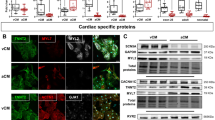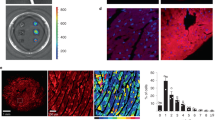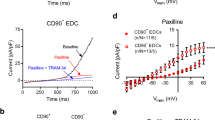Abstract
To understand molecular mechanisms that regulate formation and maintenance of cardiac IKr (rapidly activating component of the delayed rectifier K+ current), we have investigated the spatiotemporal expression pattern of two rat potassium voltage-gated channels, namely subfamily H (eag-related), member2 (KCNH2) (alias name: rERG) and Isk-related family, member2 (KCNE2) (alias name: rMiRP1) during late embryonic development by means of the in situ hybridization technique. KCNE2 is transcribed predominantly in atrial und ventricular myocardium at stages E14.5-E18.5dpc and only a minor signal emerged in the tongue at E16.5dpc. In contrast, KCNH2 transcripts appeared in a less confined pattern with intense signals in atrial and ventricular myocardium, somites, spinal cord, bowel system, central nervous system and thymus at stages E14.5-E18.5dpc. Non-cardiac expression even exceeds the intensity of the cardiac signal, indicating that KCNH2 contributes to K+ currents in non-cardiac tissue as well. Transcription of the rat β-subunit KCNE2 is present in all regions of the fetal myocardium and co-distributes perfectly with transcription of the pore forming α-subunit KCNH2. It seems likely that KCNH2 and KCNE2 are linked to form cardiac IKr channels, associated to cardiogenesis and cardiomyocyte excitability.
Similar content being viewed by others
Article PDF
Author information
Authors and Affiliations
Rights and permissions
This is an Open Access article distributed under the terms of the Creative Commons Attribution Non-Commercial License (http://creativecommons.org/licenses/by-nc/3.0/) which permits unrestricted non-commercial use, distribution, and reproduction in any medium, provided the original work is properly cited.
About this article
Cite this article
Chun, K., Koenen, M., Katus, H. et al. Expression of the IKr components KCNH2 (rERG) and KCNE2 (rMiRP1) during late rat heart development. Exp Mol Med 36, 367–371 (2004). https://doi.org/10.1038/emm.2004.48
Published:
Issue date:
DOI: https://doi.org/10.1038/emm.2004.48
Keywords
This article is cited by
-
Contribution of quantitative changes in individual ionic current systems to the embryonic development of ventricular myocytes: a simulation study
The Journal of Physiological Sciences (2013)
-
Mathematical modelling of the action potential of human embryonic stem cell derived cardiomyocytes
BioMedical Engineering OnLine (2012)
-
Transcription profiling of HCN-channel isotypes throughout mouse cardiac development
Basic Research in Cardiology (2009)
-
Altered gene expression may underlie prolonged duration of the QT interval and ventricular action potential in streptozotocin-induced diabetic rat heart
Molecular and Cellular Biochemistry (2009)
-
Regulation of the Kv2.1 Potassium Channel by MinK and MiRP1
Journal of Membrane Biology (2009)



